Social Inclusion: Historical Events, Ethics, and Legislation (INT101)
VerifiedAdded on 2023/06/04
|8
|1716
|498
Report
AI Summary
This report delves into the multifaceted concept of social inclusion within the Australian context. It begins by defining social inclusion and exploring its significance, drawing upon the framework provided by the Australian social inclusion board and UNESCO. The report then traces the historical evolution of social inclusion, highlighting key events such as the Universal Declaration of Human Rights and the Australian Human Rights Commission's reviews. It emphasizes the impact of discrimination and the ongoing efforts to address inequalities. The analysis further examines current ethical and legislative requirements, referencing the Australian Community Workers Association's code of ethics and the government's initiatives aimed at fostering economic participation and reducing disparities. The report underscores the importance of community work and the need for societal shifts to achieve genuine social inclusion. It concludes by emphasizing the potential for positive change through collaborative efforts across various sectors.
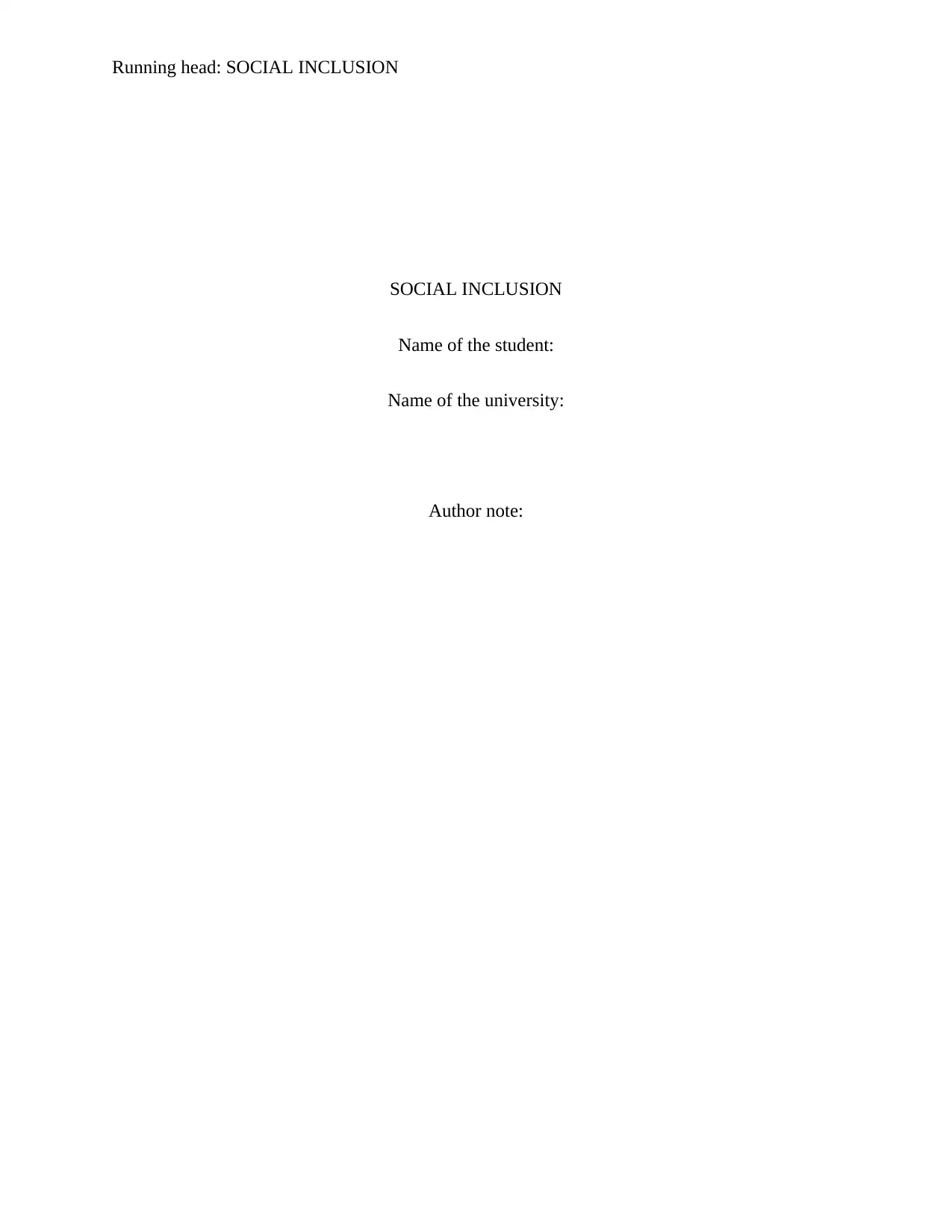
Running head: SOCIAL INCLUSION
SOCIAL INCLUSION
Name of the student:
Name of the university:
Author note:
SOCIAL INCLUSION
Name of the student:
Name of the university:
Author note:
Paraphrase This Document
Need a fresh take? Get an instant paraphrase of this document with our AI Paraphraser
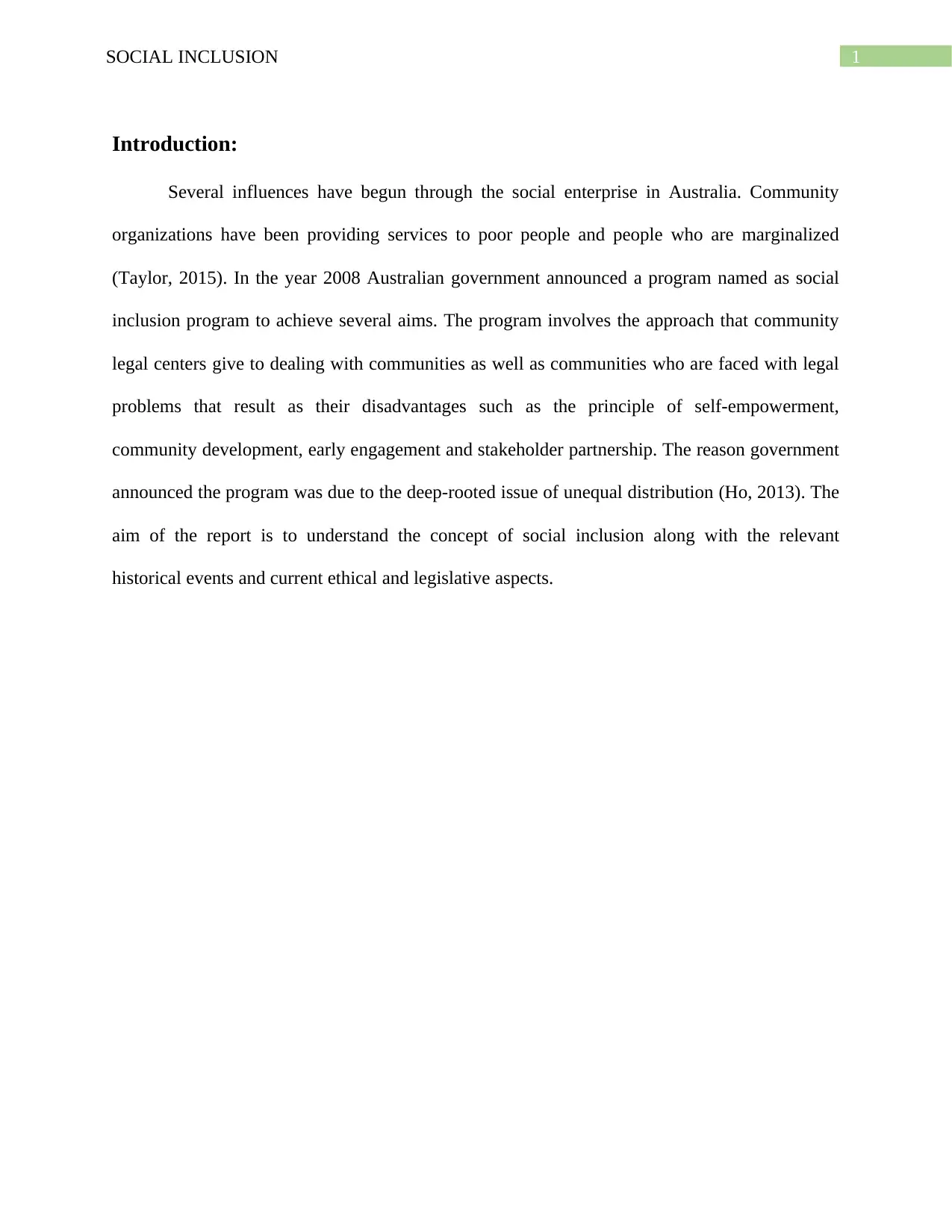
1SOCIAL INCLUSION
Introduction:
Several influences have begun through the social enterprise in Australia. Community
organizations have been providing services to poor people and people who are marginalized
(Taylor, 2015). In the year 2008 Australian government announced a program named as social
inclusion program to achieve several aims. The program involves the approach that community
legal centers give to dealing with communities as well as communities who are faced with legal
problems that result as their disadvantages such as the principle of self-empowerment,
community development, early engagement and stakeholder partnership. The reason government
announced the program was due to the deep-rooted issue of unequal distribution (Ho, 2013). The
aim of the report is to understand the concept of social inclusion along with the relevant
historical events and current ethical and legislative aspects.
Introduction:
Several influences have begun through the social enterprise in Australia. Community
organizations have been providing services to poor people and people who are marginalized
(Taylor, 2015). In the year 2008 Australian government announced a program named as social
inclusion program to achieve several aims. The program involves the approach that community
legal centers give to dealing with communities as well as communities who are faced with legal
problems that result as their disadvantages such as the principle of self-empowerment,
community development, early engagement and stakeholder partnership. The reason government
announced the program was due to the deep-rooted issue of unequal distribution (Ho, 2013). The
aim of the report is to understand the concept of social inclusion along with the relevant
historical events and current ethical and legislative aspects.
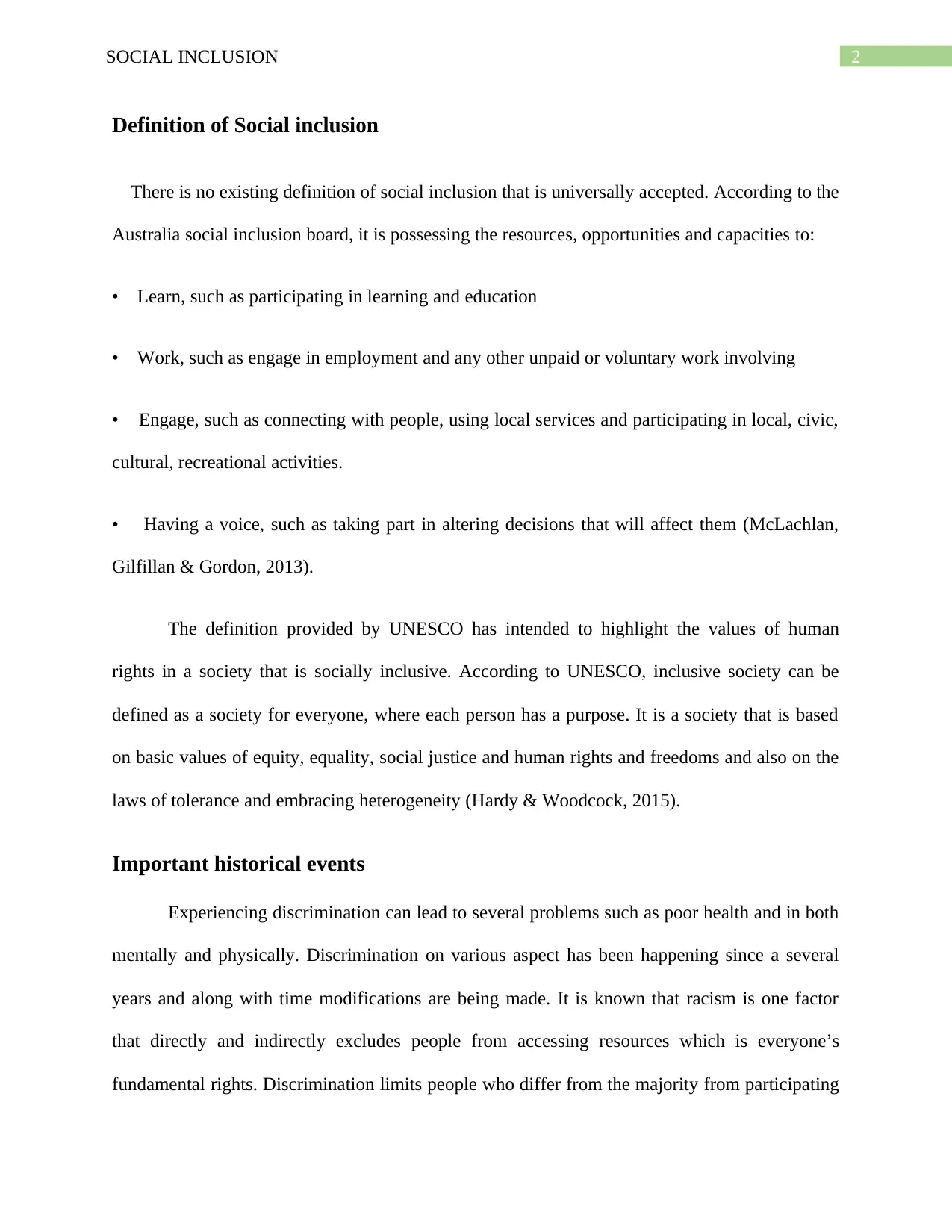
2SOCIAL INCLUSION
Definition of Social inclusion
There is no existing definition of social inclusion that is universally accepted. According to the
Australia social inclusion board, it is possessing the resources, opportunities and capacities to:
• Learn, such as participating in learning and education
• Work, such as engage in employment and any other unpaid or voluntary work involving
• Engage, such as connecting with people, using local services and participating in local, civic,
cultural, recreational activities.
• Having a voice, such as taking part in altering decisions that will affect them (McLachlan,
Gilfillan & Gordon, 2013).
The definition provided by UNESCO has intended to highlight the values of human
rights in a society that is socially inclusive. According to UNESCO, inclusive society can be
defined as a society for everyone, where each person has a purpose. It is a society that is based
on basic values of equity, equality, social justice and human rights and freedoms and also on the
laws of tolerance and embracing heterogeneity (Hardy & Woodcock, 2015).
Important historical events
Experiencing discrimination can lead to several problems such as poor health and in both
mentally and physically. Discrimination on various aspect has been happening since a several
years and along with time modifications are being made. It is known that racism is one factor
that directly and indirectly excludes people from accessing resources which is everyone’s
fundamental rights. Discrimination limits people who differ from the majority from participating
Definition of Social inclusion
There is no existing definition of social inclusion that is universally accepted. According to the
Australia social inclusion board, it is possessing the resources, opportunities and capacities to:
• Learn, such as participating in learning and education
• Work, such as engage in employment and any other unpaid or voluntary work involving
• Engage, such as connecting with people, using local services and participating in local, civic,
cultural, recreational activities.
• Having a voice, such as taking part in altering decisions that will affect them (McLachlan,
Gilfillan & Gordon, 2013).
The definition provided by UNESCO has intended to highlight the values of human
rights in a society that is socially inclusive. According to UNESCO, inclusive society can be
defined as a society for everyone, where each person has a purpose. It is a society that is based
on basic values of equity, equality, social justice and human rights and freedoms and also on the
laws of tolerance and embracing heterogeneity (Hardy & Woodcock, 2015).
Important historical events
Experiencing discrimination can lead to several problems such as poor health and in both
mentally and physically. Discrimination on various aspect has been happening since a several
years and along with time modifications are being made. It is known that racism is one factor
that directly and indirectly excludes people from accessing resources which is everyone’s
fundamental rights. Discrimination limits people who differ from the majority from participating
⊘ This is a preview!⊘
Do you want full access?
Subscribe today to unlock all pages.

Trusted by 1+ million students worldwide
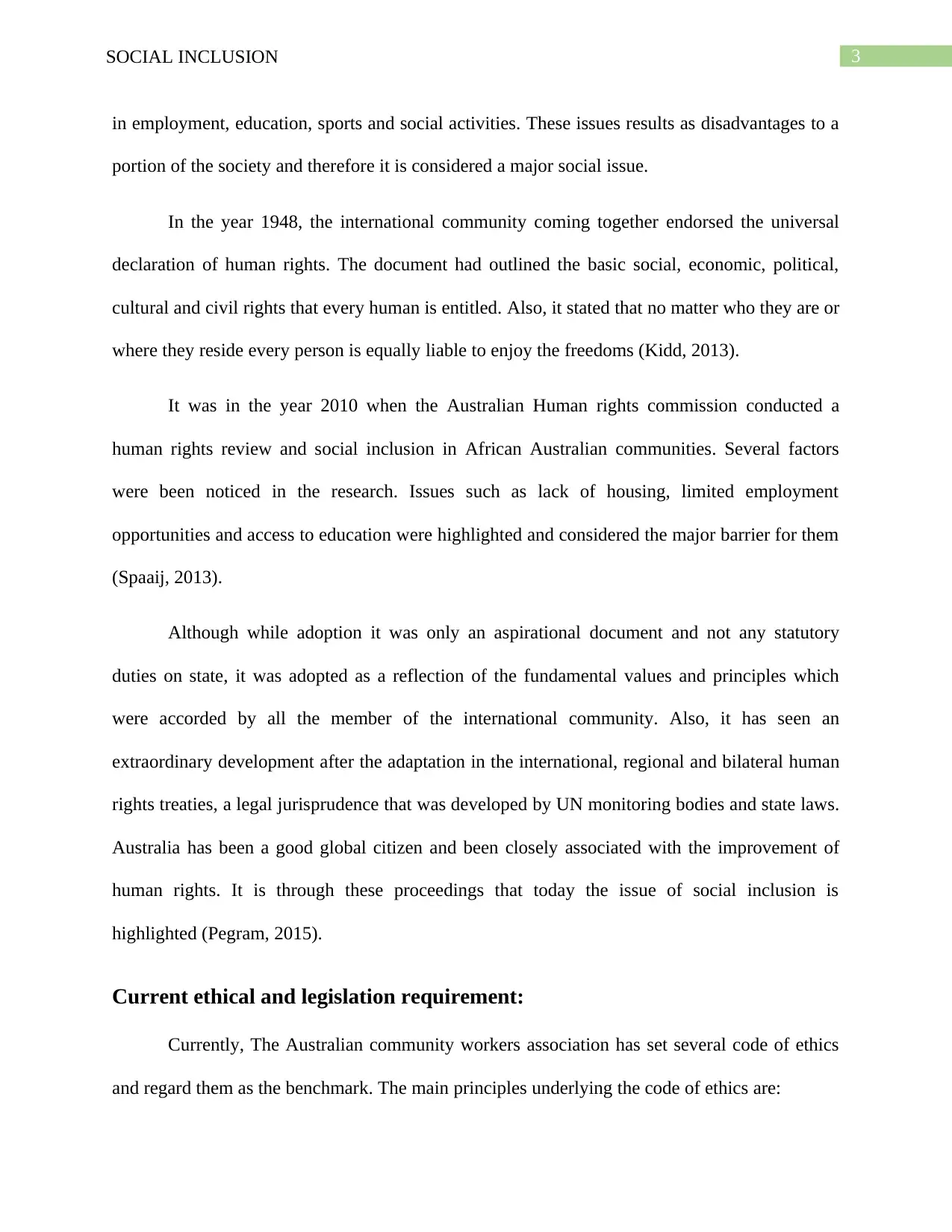
3SOCIAL INCLUSION
in employment, education, sports and social activities. These issues results as disadvantages to a
portion of the society and therefore it is considered a major social issue.
In the year 1948, the international community coming together endorsed the universal
declaration of human rights. The document had outlined the basic social, economic, political,
cultural and civil rights that every human is entitled. Also, it stated that no matter who they are or
where they reside every person is equally liable to enjoy the freedoms (Kidd, 2013).
It was in the year 2010 when the Australian Human rights commission conducted a
human rights review and social inclusion in African Australian communities. Several factors
were been noticed in the research. Issues such as lack of housing, limited employment
opportunities and access to education were highlighted and considered the major barrier for them
(Spaaij, 2013).
Although while adoption it was only an aspirational document and not any statutory
duties on state, it was adopted as a reflection of the fundamental values and principles which
were accorded by all the member of the international community. Also, it has seen an
extraordinary development after the adaptation in the international, regional and bilateral human
rights treaties, a legal jurisprudence that was developed by UN monitoring bodies and state laws.
Australia has been a good global citizen and been closely associated with the improvement of
human rights. It is through these proceedings that today the issue of social inclusion is
highlighted (Pegram, 2015).
Current ethical and legislation requirement:
Currently, The Australian community workers association has set several code of ethics
and regard them as the benchmark. The main principles underlying the code of ethics are:
in employment, education, sports and social activities. These issues results as disadvantages to a
portion of the society and therefore it is considered a major social issue.
In the year 1948, the international community coming together endorsed the universal
declaration of human rights. The document had outlined the basic social, economic, political,
cultural and civil rights that every human is entitled. Also, it stated that no matter who they are or
where they reside every person is equally liable to enjoy the freedoms (Kidd, 2013).
It was in the year 2010 when the Australian Human rights commission conducted a
human rights review and social inclusion in African Australian communities. Several factors
were been noticed in the research. Issues such as lack of housing, limited employment
opportunities and access to education were highlighted and considered the major barrier for them
(Spaaij, 2013).
Although while adoption it was only an aspirational document and not any statutory
duties on state, it was adopted as a reflection of the fundamental values and principles which
were accorded by all the member of the international community. Also, it has seen an
extraordinary development after the adaptation in the international, regional and bilateral human
rights treaties, a legal jurisprudence that was developed by UN monitoring bodies and state laws.
Australia has been a good global citizen and been closely associated with the improvement of
human rights. It is through these proceedings that today the issue of social inclusion is
highlighted (Pegram, 2015).
Current ethical and legislation requirement:
Currently, The Australian community workers association has set several code of ethics
and regard them as the benchmark. The main principles underlying the code of ethics are:
Paraphrase This Document
Need a fresh take? Get an instant paraphrase of this document with our AI Paraphraser
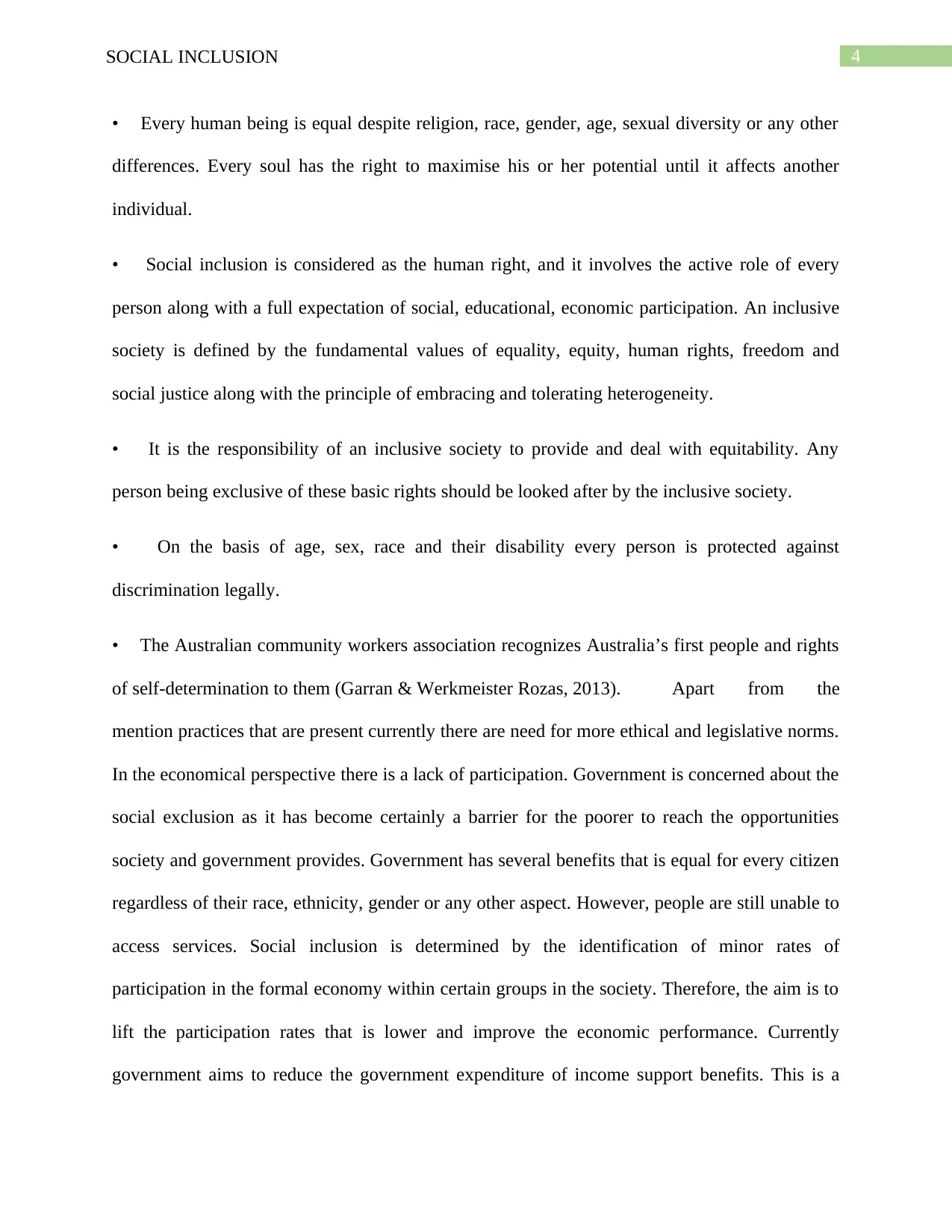
4SOCIAL INCLUSION
• Every human being is equal despite religion, race, gender, age, sexual diversity or any other
differences. Every soul has the right to maximise his or her potential until it affects another
individual.
• Social inclusion is considered as the human right, and it involves the active role of every
person along with a full expectation of social, educational, economic participation. An inclusive
society is defined by the fundamental values of equality, equity, human rights, freedom and
social justice along with the principle of embracing and tolerating heterogeneity.
• It is the responsibility of an inclusive society to provide and deal with equitability. Any
person being exclusive of these basic rights should be looked after by the inclusive society.
• On the basis of age, sex, race and their disability every person is protected against
discrimination legally.
• The Australian community workers association recognizes Australia’s first people and rights
of self-determination to them (Garran & Werkmeister Rozas, 2013). Apart from the
mention practices that are present currently there are need for more ethical and legislative norms.
In the economical perspective there is a lack of participation. Government is concerned about the
social exclusion as it has become certainly a barrier for the poorer to reach the opportunities
society and government provides. Government has several benefits that is equal for every citizen
regardless of their race, ethnicity, gender or any other aspect. However, people are still unable to
access services. Social inclusion is determined by the identification of minor rates of
participation in the formal economy within certain groups in the society. Therefore, the aim is to
lift the participation rates that is lower and improve the economic performance. Currently
government aims to reduce the government expenditure of income support benefits. This is a
• Every human being is equal despite religion, race, gender, age, sexual diversity or any other
differences. Every soul has the right to maximise his or her potential until it affects another
individual.
• Social inclusion is considered as the human right, and it involves the active role of every
person along with a full expectation of social, educational, economic participation. An inclusive
society is defined by the fundamental values of equality, equity, human rights, freedom and
social justice along with the principle of embracing and tolerating heterogeneity.
• It is the responsibility of an inclusive society to provide and deal with equitability. Any
person being exclusive of these basic rights should be looked after by the inclusive society.
• On the basis of age, sex, race and their disability every person is protected against
discrimination legally.
• The Australian community workers association recognizes Australia’s first people and rights
of self-determination to them (Garran & Werkmeister Rozas, 2013). Apart from the
mention practices that are present currently there are need for more ethical and legislative norms.
In the economical perspective there is a lack of participation. Government is concerned about the
social exclusion as it has become certainly a barrier for the poorer to reach the opportunities
society and government provides. Government has several benefits that is equal for every citizen
regardless of their race, ethnicity, gender or any other aspect. However, people are still unable to
access services. Social inclusion is determined by the identification of minor rates of
participation in the formal economy within certain groups in the society. Therefore, the aim is to
lift the participation rates that is lower and improve the economic performance. Currently
government aims to reduce the government expenditure of income support benefits. This is a
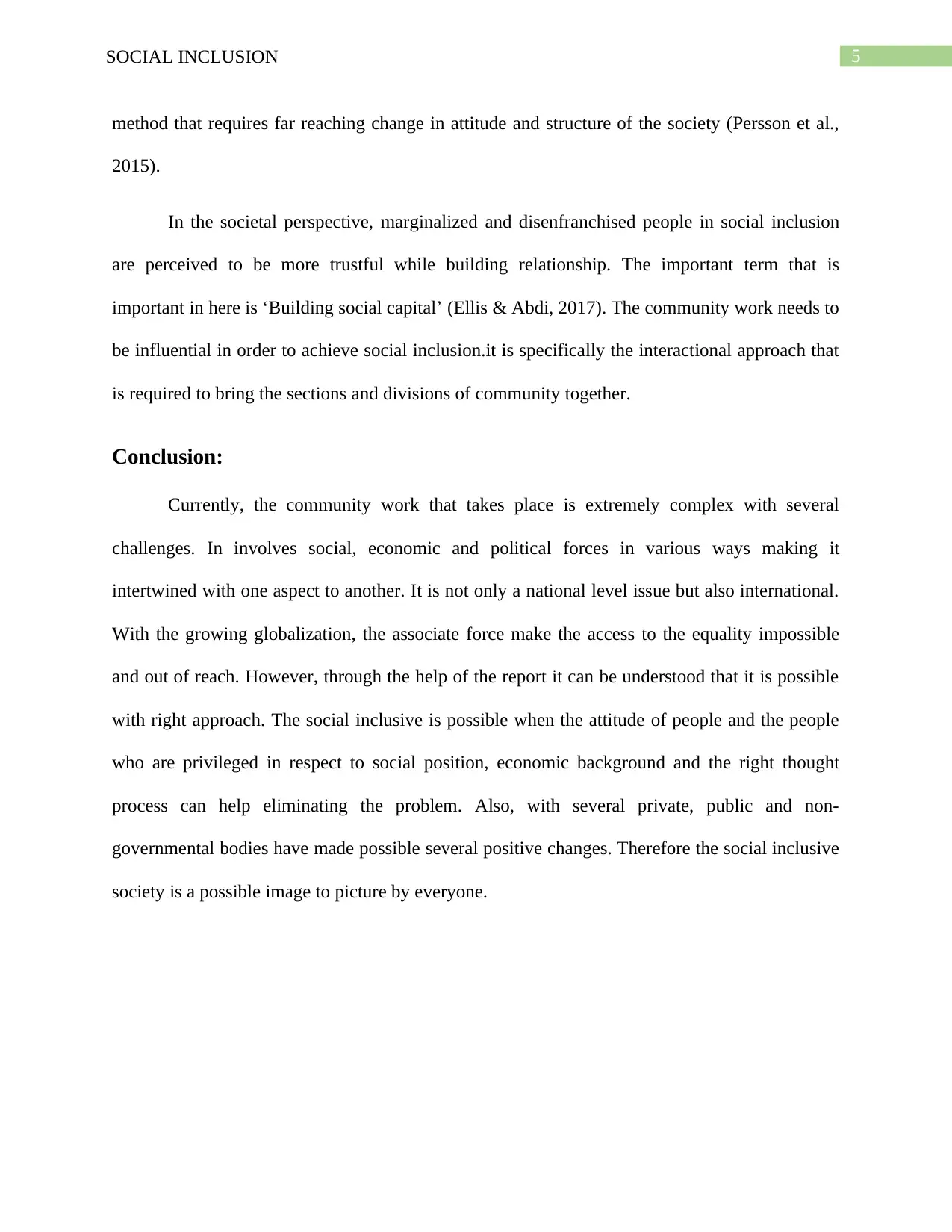
5SOCIAL INCLUSION
method that requires far reaching change in attitude and structure of the society (Persson et al.,
2015).
In the societal perspective, marginalized and disenfranchised people in social inclusion
are perceived to be more trustful while building relationship. The important term that is
important in here is ‘Building social capital’ (Ellis & Abdi, 2017). The community work needs to
be influential in order to achieve social inclusion.it is specifically the interactional approach that
is required to bring the sections and divisions of community together.
Conclusion:
Currently, the community work that takes place is extremely complex with several
challenges. In involves social, economic and political forces in various ways making it
intertwined with one aspect to another. It is not only a national level issue but also international.
With the growing globalization, the associate force make the access to the equality impossible
and out of reach. However, through the help of the report it can be understood that it is possible
with right approach. The social inclusive is possible when the attitude of people and the people
who are privileged in respect to social position, economic background and the right thought
process can help eliminating the problem. Also, with several private, public and non-
governmental bodies have made possible several positive changes. Therefore the social inclusive
society is a possible image to picture by everyone.
method that requires far reaching change in attitude and structure of the society (Persson et al.,
2015).
In the societal perspective, marginalized and disenfranchised people in social inclusion
are perceived to be more trustful while building relationship. The important term that is
important in here is ‘Building social capital’ (Ellis & Abdi, 2017). The community work needs to
be influential in order to achieve social inclusion.it is specifically the interactional approach that
is required to bring the sections and divisions of community together.
Conclusion:
Currently, the community work that takes place is extremely complex with several
challenges. In involves social, economic and political forces in various ways making it
intertwined with one aspect to another. It is not only a national level issue but also international.
With the growing globalization, the associate force make the access to the equality impossible
and out of reach. However, through the help of the report it can be understood that it is possible
with right approach. The social inclusive is possible when the attitude of people and the people
who are privileged in respect to social position, economic background and the right thought
process can help eliminating the problem. Also, with several private, public and non-
governmental bodies have made possible several positive changes. Therefore the social inclusive
society is a possible image to picture by everyone.
⊘ This is a preview!⊘
Do you want full access?
Subscribe today to unlock all pages.

Trusted by 1+ million students worldwide
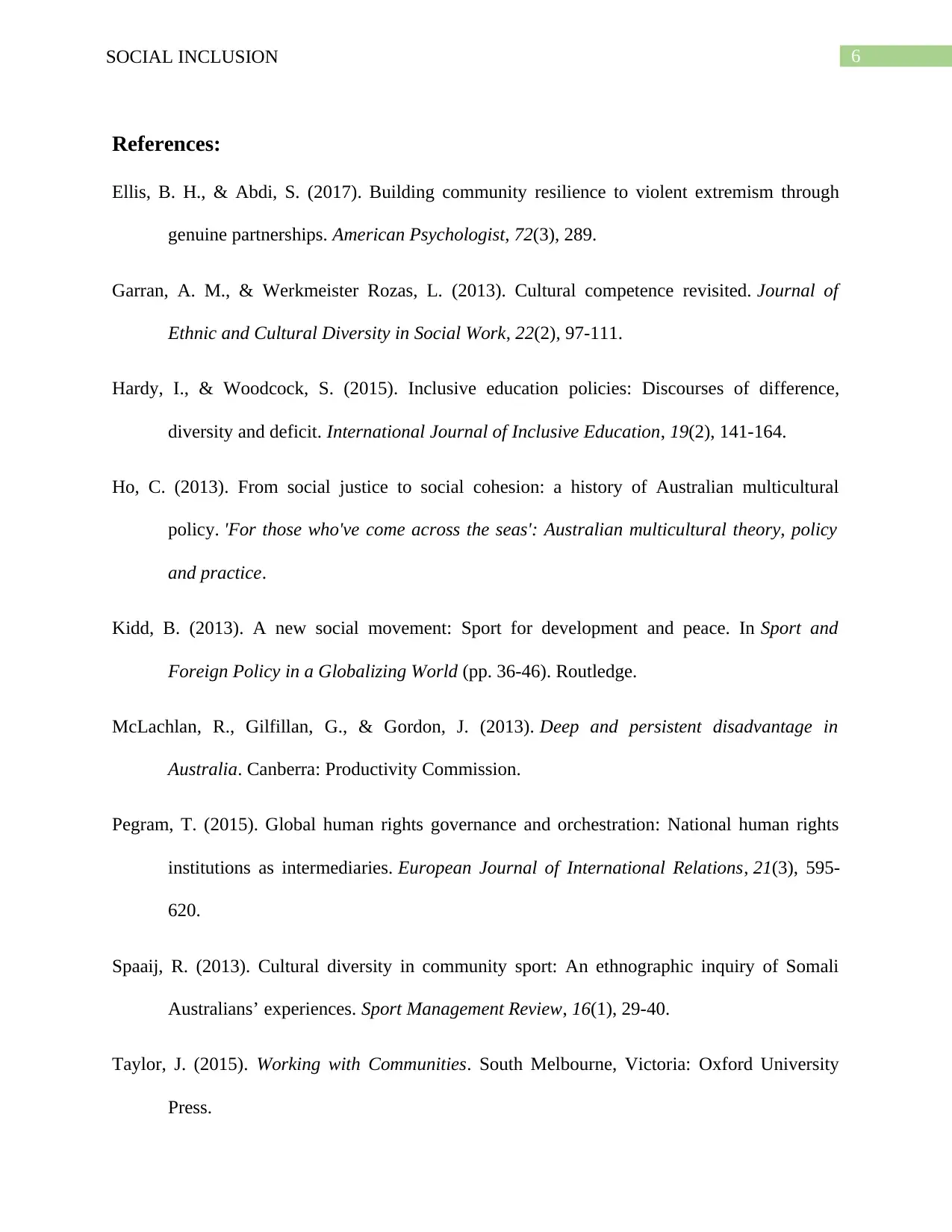
6SOCIAL INCLUSION
References:
Ellis, B. H., & Abdi, S. (2017). Building community resilience to violent extremism through
genuine partnerships. American Psychologist, 72(3), 289.
Garran, A. M., & Werkmeister Rozas, L. (2013). Cultural competence revisited. Journal of
Ethnic and Cultural Diversity in Social Work, 22(2), 97-111.
Hardy, I., & Woodcock, S. (2015). Inclusive education policies: Discourses of difference,
diversity and deficit. International Journal of Inclusive Education, 19(2), 141-164.
Ho, C. (2013). From social justice to social cohesion: a history of Australian multicultural
policy. 'For those who've come across the seas': Australian multicultural theory, policy
and practice.
Kidd, B. (2013). A new social movement: Sport for development and peace. In Sport and
Foreign Policy in a Globalizing World (pp. 36-46). Routledge.
McLachlan, R., Gilfillan, G., & Gordon, J. (2013). Deep and persistent disadvantage in
Australia. Canberra: Productivity Commission.
Pegram, T. (2015). Global human rights governance and orchestration: National human rights
institutions as intermediaries. European Journal of International Relations, 21(3), 595-
620.
Spaaij, R. (2013). Cultural diversity in community sport: An ethnographic inquiry of Somali
Australians’ experiences. Sport Management Review, 16(1), 29-40.
Taylor, J. (2015). Working with Communities. South Melbourne, Victoria: Oxford University
Press.
References:
Ellis, B. H., & Abdi, S. (2017). Building community resilience to violent extremism through
genuine partnerships. American Psychologist, 72(3), 289.
Garran, A. M., & Werkmeister Rozas, L. (2013). Cultural competence revisited. Journal of
Ethnic and Cultural Diversity in Social Work, 22(2), 97-111.
Hardy, I., & Woodcock, S. (2015). Inclusive education policies: Discourses of difference,
diversity and deficit. International Journal of Inclusive Education, 19(2), 141-164.
Ho, C. (2013). From social justice to social cohesion: a history of Australian multicultural
policy. 'For those who've come across the seas': Australian multicultural theory, policy
and practice.
Kidd, B. (2013). A new social movement: Sport for development and peace. In Sport and
Foreign Policy in a Globalizing World (pp. 36-46). Routledge.
McLachlan, R., Gilfillan, G., & Gordon, J. (2013). Deep and persistent disadvantage in
Australia. Canberra: Productivity Commission.
Pegram, T. (2015). Global human rights governance and orchestration: National human rights
institutions as intermediaries. European Journal of International Relations, 21(3), 595-
620.
Spaaij, R. (2013). Cultural diversity in community sport: An ethnographic inquiry of Somali
Australians’ experiences. Sport Management Review, 16(1), 29-40.
Taylor, J. (2015). Working with Communities. South Melbourne, Victoria: Oxford University
Press.
Paraphrase This Document
Need a fresh take? Get an instant paraphrase of this document with our AI Paraphraser
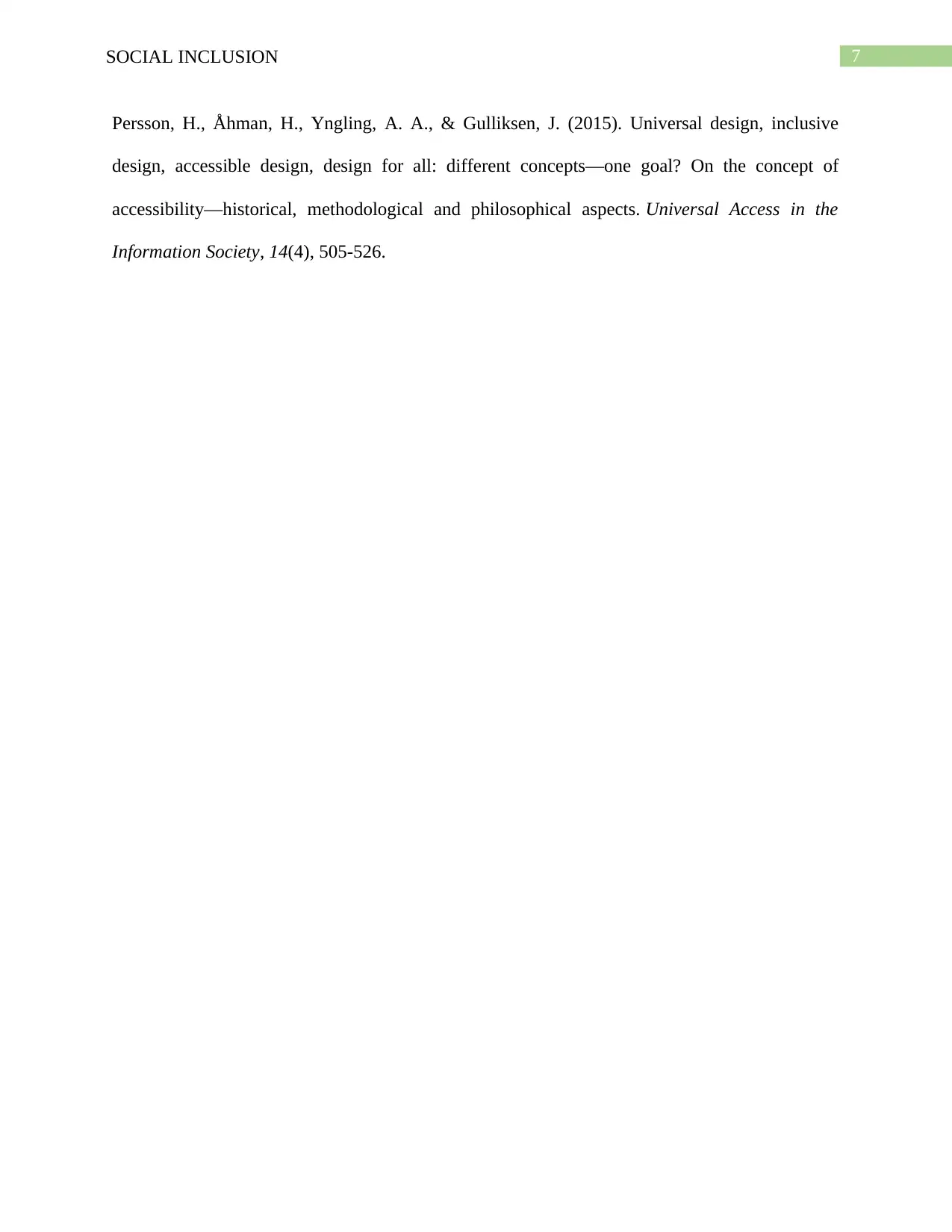
7SOCIAL INCLUSION
Persson, H., Åhman, H., Yngling, A. A., & Gulliksen, J. (2015). Universal design, inclusive
design, accessible design, design for all: different concepts—one goal? On the concept of
accessibility—historical, methodological and philosophical aspects. Universal Access in the
Information Society, 14(4), 505-526.
Persson, H., Åhman, H., Yngling, A. A., & Gulliksen, J. (2015). Universal design, inclusive
design, accessible design, design for all: different concepts—one goal? On the concept of
accessibility—historical, methodological and philosophical aspects. Universal Access in the
Information Society, 14(4), 505-526.
1 out of 8
Related Documents
Your All-in-One AI-Powered Toolkit for Academic Success.
+13062052269
info@desklib.com
Available 24*7 on WhatsApp / Email
![[object Object]](/_next/static/media/star-bottom.7253800d.svg)
Unlock your academic potential
Copyright © 2020–2025 A2Z Services. All Rights Reserved. Developed and managed by ZUCOL.





